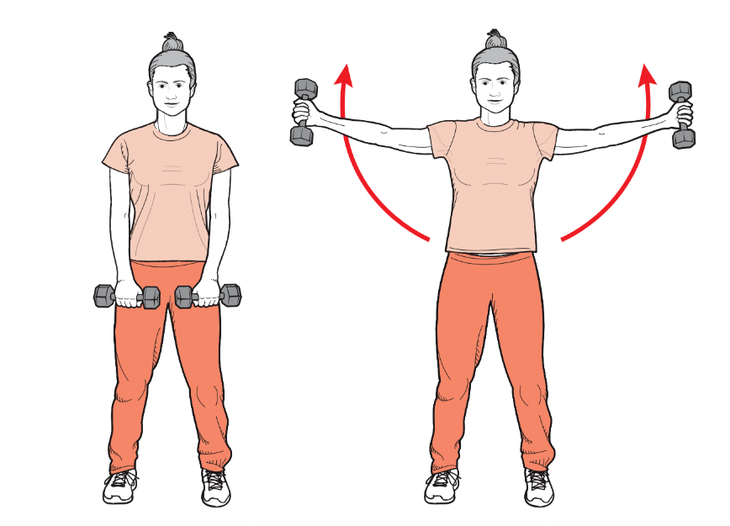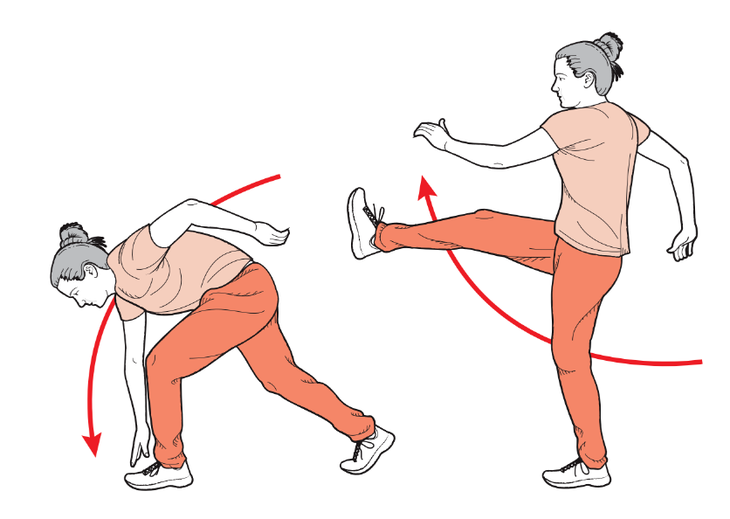Products You May Like
Mobility refers to the ease with which your joints move throughout their range of motion. Having mobile joints can minimize your risk of injury and lead to reduced pain while you hike. Don’t confuse mobility with flexibility: Contrary to popular belief, stretching doesn’t help with mobility.
Training to improve mobility should include compound movements: those that take you through the full range of motion, not just the easily-accessed middle.
With mobility exercises, it is important to be intentional; that is, to concentrate on what you are feeling at the joints involved. Begin by completing the following exercises at a low intensity at least once per week—though the more you do it, the better you’ll feel. As you get comfortable, you can increase the difficulty.
Warmup
Cat-Cow
Get on all fours, ensuring that your knees are directly below your hips and your wrists are directly below your shoulders. For the “cat” part of this movement, lift your spine toward the sky, imitating a scared feline. Lower your gaze toward your knees, focusing on separating each vertebrae from its neighbor. After a few seconds, slowly relax the arch in your back and let your belly button sink toward the floor. Push back with your tailbone and cast your gaze upward for “cow.” Hold for a few seconds and repeat three to four times.

Lunge with Rotation
Get into a straight-arm plank with your wrists under your shoulders. Bring your right foot just inside of your right hand. Extend your right arm, supporting your weight with your left hand and right foot, and rotate your spine until your right hand is directly above your right shoulder, creating a straight line between your two hands. Hold for two to three seconds. Breathe. Rotate to the left so that your right hand slides behind your left wrist, palm up. Reach as far as you are able without discomfort.
Hold for two to three seconds, remembering to breathe. Repeat the cycle three to four times on each side of your body. If this is too difficult, try performing the movement with your rear knee on the ground.
Over-and-Back
This movement requires a prop: It can be a broomstick, a piece of PVC pipe, a belt, a thick resistance band, or whatever item you have around that is at least a few feet long. From standing, grasp the stick across your thighs with a wide grip, fingers facing your body. Relax and lower your shoulders.
Gently lift the stick overhead; try to keep it horizontal. If using a belt or resistance band, keep your arms wide so it stays taut. Slowly lower it behind your head. With intention, focus on feeling your shoulder blades move over your ribcage and the shoulder joints open up. Take a breath and return to the start. Repeat 10 to 12 times.
Happy Baby
Lie on your back. With your head on the ground, flex your hips and bend your knees 90 degrees. The soles of your feet should face the ceiling. Separate your knees so that they are wider than your shoulders. Grasp each foot, either from the inside or outside. Rock from side to side, your arms and legs moving as a unit. Move until your body lets you know it’s happy.
Mobility Exercises
Perform three sets of each of the following.
8 to 10 Overhead Kettlebell Holds with Squat Touch (per side)
Hold a 5- to 8-pound kettlebell overhead in your right hand, with the bell over the handle. Squat, at the lowest point reaching down with your left hand to touch the ground near the outside of your left foot. Stand, keeping the kettlebell aloft.

8 to 10 Frontal Plane Scapular Raises
Stand with your feet shoulder-width apart, knees bent slightly, spine straight. Hold a 3- to 5-pound dumbbell in each hand. Lead with your thumbs as you slowly lift the weights in a jumping jack motion. Stop when your hands are shoulder high. Lower them to the starting position, keeping your thumbs up until the end.
Active Bar Hang
Grab a pull-up or monkey bar with both hands set wider than your shoulders. Lift your feet or move off a support step and hang. Relax your neck and shoulder muscles. Feel the space between your ribs and vertebrae expand. Hold for as long as your hands allow; grip fatigue usually signals the end of the rep. Ready for more of a challenge? Rotate at the spine, turning your hips to the left, back to center, and then to the right. Repeat until fatigued.

10 Charlestons (per side)
From standing, take a step forward with your left foot so your feet are staggered. Bend over and touch your right hand to the ground. As you return to standing, swing your right leg forward at the hip. Lean forward as you swing your leg behind you, tapping the ground with your right fingers.
8 to 12 Drinking Birds (per side)
Stand with your feet together. Keep your spine and right leg straight as you bend at the hip, lifting your left leg out behind you so it’s parallel to the ground. You can keep your arms at your side, reach forward, or raise your arms for balance. Complete all reps on this foot, then switch sides.
THE EXPERT: Kaelyn Silva, CSCS, is the owner of Pasadena Sport Science in Pasadena, California. When she’s not training clients, she enjoys hiking with her dogs in the Ansel Adams Wilderness.
